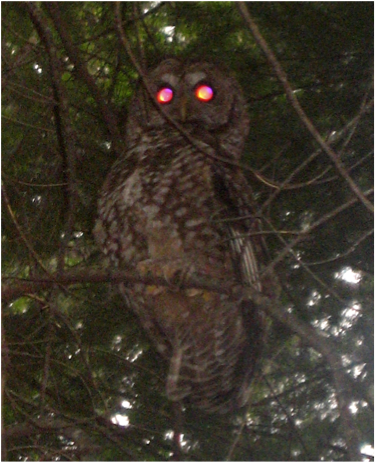Impacts of forest fuel treatments and wildfire on forests
 Monday, December 14, 2015 at 9:33AM
Monday, December 14, 2015 at 9:33AM Tempel, DJ, RJ Gutiérrez, JJ Battles, DL Fry, Y Su, Q Guo, MJ Reetz, SA Whitmore, GM Jones, BM Collins, SL Stephens, M Kelly, WJ Berigan, and MZ Peery. 2015. Modeling short- and long-term impacts of fuel treatments and wildfire on an old-forest species. Ecosphere 6(12) DOI:10.1890/ES15-00234.1
 Fuels-reduction treatments are commonly implemented in the western U.S. to reduce the risk of high-severity fire, but they may have negative short-term impacts on species associated with older forests. Therefore, we modeled the effects of a completed fuels-reduction project on fire behavior and California spotted owl (Strix occidentalis occidentalis) habitat and demography in the Sierra Nevada to assess the potential short- and long-term trade-offs. We combined field-collected vegetation data and LiDAR data to develop detailed maps of forest structure needed to parameterize our fire and forest-growth models. We simulated wildfires under extreme weather conditions (both with and without fuels treatments), then simulated forest growth 30 years into the future under four combinations of treatment and fire: treated with fire, untreated with fire, treated without fire, and untreated without fire. We compared spotted owl habitat and population parameters under the four scenarios using a habitat suitability index developed from canopy cover and large-tree measurements at nest sites and from previously derived statistical relationships between forest structure and fitness (λ) and equilibrium occupancy at the territory scale. Treatments had a positive effect on owl nesting habitat and demographic rates up to 30 years after simulated fire, but they had a persistently negative effect throughout the 30-year period in the absence of fire. We conclude that fuels-reduction treatments in the Sierra Nevada may provide long-term benefits to spotted owls if fire occurs under extreme weather conditions, but can have long-term negative effects on owls if fire does not occur. However, we only simulated one fire under the treated and untreated scenarios and therefore had no measures of variation and uncertainty. In addition, the net benefits of fuels treatments on spotted owl habitat and demography will depend on the future probability that fire will occur under similar weather and ignition conditions, and such probabilities remain difficult to quantify. Therefore, we recommend adopting a landscape approach that restricts timber harvest within territory core areas of use (~125 ha in size) that contain critical owl nesting and roosting habitat and locates fuels treatments in the surrounding areas to reduce hazardous fire potential.
Fuels-reduction treatments are commonly implemented in the western U.S. to reduce the risk of high-severity fire, but they may have negative short-term impacts on species associated with older forests. Therefore, we modeled the effects of a completed fuels-reduction project on fire behavior and California spotted owl (Strix occidentalis occidentalis) habitat and demography in the Sierra Nevada to assess the potential short- and long-term trade-offs. We combined field-collected vegetation data and LiDAR data to develop detailed maps of forest structure needed to parameterize our fire and forest-growth models. We simulated wildfires under extreme weather conditions (both with and without fuels treatments), then simulated forest growth 30 years into the future under four combinations of treatment and fire: treated with fire, untreated with fire, treated without fire, and untreated without fire. We compared spotted owl habitat and population parameters under the four scenarios using a habitat suitability index developed from canopy cover and large-tree measurements at nest sites and from previously derived statistical relationships between forest structure and fitness (λ) and equilibrium occupancy at the territory scale. Treatments had a positive effect on owl nesting habitat and demographic rates up to 30 years after simulated fire, but they had a persistently negative effect throughout the 30-year period in the absence of fire. We conclude that fuels-reduction treatments in the Sierra Nevada may provide long-term benefits to spotted owls if fire occurs under extreme weather conditions, but can have long-term negative effects on owls if fire does not occur. However, we only simulated one fire under the treated and untreated scenarios and therefore had no measures of variation and uncertainty. In addition, the net benefits of fuels treatments on spotted owl habitat and demography will depend on the future probability that fire will occur under similar weather and ignition conditions, and such probabilities remain difficult to quantify. Therefore, we recommend adopting a landscape approach that restricts timber harvest within territory core areas of use (~125 ha in size) that contain critical owl nesting and roosting habitat and locates fuels treatments in the surrounding areas to reduce hazardous fire potential.
 fire,
fire,  forests,
forests,  last chance,
last chance,  snamp
snamp